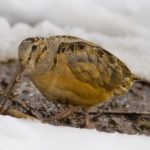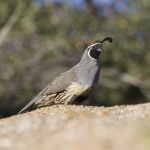The last three years have collectively provided the best bobwhite quail hunting of a generation in the states that account for the bulk of the wild bobwhite harvest, including Texas, Oklahoma, Kansas, Nebraska, and Iowa. The peak was staggered a bit, but the hunting was absolutely phenomenal in a couple of those states from the 2015-’16 season through last year. While this year’s weather may not have been what it takes to produce a bobwhite boom, it was good enough that hunters in those states will experience some memorable quail hunting this fall and winter.
Texas produced the bobwhite hunting of a lifetime in 2016-’17 thanks to the alignment of good habitat and perfect weather patterns. The 2016 roadside surveys in the Rolling Plains yielded an average of 50.2 quail per transect, the highest count since the survey began in 1978. The country was drier last year, but quail numbers were still above average, which, as Robert Perez, Texas Department of Wildlife & Parks, puts it, “is better than almost anywhere else in the country.” This spring was shaping up to produce another downturn as some areas went over 100 days without rain. However, the rains came in June and some of the good quail country was fantastic by mid-summer, said Perez. “The northeast Panhandle and the area around Abilene are looking really good. In contrast, the central Panhandle from Paducah to west of Lubbock has been drier and reproduction is expected to be limited. It is looking like an average to slightly below-average year in the Rolling Plains.” South Texas is a mixed bag. The northeast portion of that region just south of Hondo-Sabinal-Knippa looks great due to well-spaced summer rains. However, the southern half of South Texas didn’t receive enough precipitation to offset July’s high temperatures.
Kansas may be the bobwhite destination this fall! Last year’s roadside surveys revealed a 20-year high for bobwhites, and this spring/summer looks promising. According to Prendergast, the state had very little winter precipitation, but the moisture picked up in late April and continued through the summer across western Kansas, greatly improving nesting cover and brood habitat. Quail numbers increased substantially in the southwest region, coming off losses from the 2017 late-spring blizzard. Prendergast expects that the weedy cover produced by rains this summer will keep quail numbers extremely high. Eastern Kansas reports favorable nesting conditions, as well.
In Nebraska, bobwhite numbers increased statewide by 25 percent from 2017 and are 53 percent over the 10-year high, according to Lusk. The April Rural Mail Carrier Survey revealed an astounding 380-percent increase in the West Platte Region. Weather conditions were good early but hot and dry this summer, so it’s too early to know the outcome. Iowa is coming off a good quail season, and Bogenschutz was optimistic regarding bobwhites. “Quail prospects look good across the southern third of Iowa. We had virtually no winter along the Missouri border, so overwinter survival was good.” Likewise, Missouri is poised for another uptick in bobwhite numbers. Dave Hoover, Missouri Department of Conservation, anticipates a slight increase in the northern and western portions of Missouri where habitat conditions are favorable.
It’s less rosy in Oklahoma and Colorado. The drought has extended into western Oklahoma and left most of the good quail country parched, said Kyle Johnson, Oklahoma Department of Wildlife Conservation. In Colorado, Gorman anticipates very low numbers in southeastern Colorado and probably average bobwhite populations in the northeast region.
Bobwhite populations are on the upswing in South Carolina, Arkansas, and Tennessee. The state fish and wildlife agencies are working extremely hard to improve quail habitat, and it is showing results. Michael Hook, South Carolina DNR, reports that bobwhite populations have increased in South Carolina each of the last two years and may again this year. The DNR recorded all-time high counts for a couple of properties the last two years. Over 19,000 acres of habitat work has been completed for quail in Arkansas, according to Marcus Asher, Arkansas Game & Fish Commission. He notes that the Arkansas River Valley, Ozarks, and Ouachitas should have the best numbers of quail this year. In Tennessee, the Wolf River WMA has been selected as a Coordinated Implementation Program focus area for the National Bobwhite Conservation Initiative, and there will be lots of quail habitat work in that region, according to Roger Applegate, Tennessee Wildlife Resources Agency.
In Florida, the 2017 harvest was down in central and south Florida due to impacts from tropical storms; but in northern Florida, the harvest was on par with past years, according to Greg Hagan, Florida Fish and Wildlife Commission. Spring and summer weather has been conducive to good nesting and brood-rearing, so Florida is poised for a bobwhite uptick this fall.
Quail populations in Illinois, Ohio, and North Carolina remain chronically low, according to the state fish and wildlife agencies.
E-Blast Update: October 2018
Iowa is still riding the crest of a modern-era bobwhite boom. The last four years represent the highest quail indices in the last 20 years, and this year was even better! The bobwhite quail index was 1.36 birds/route, a significant increase from last year and 62 percent above the 10-year average. In Kansas, heavy summer rains contributed to declining quail populations in most regions, but good quail populations still exist in central Kansas extending east into the Flint Hills. The south-central prairies exhibit excellent intermixing of quail cover, and some of the field reports indicate quail reproduction may have been better than indicated by the August roadside surveys. Likewise, the Smoky Hills of north-central Kansas will offer some good bobwhite hunting. In Nebraska, quail numbers declined by 28 percent statewide, but the quail population is still four percent above the five-year average. In relation to the five-year averages, quail numbers are strong in the Republican (+22 percent), Southeast (+21 percent), and East-Central (+89 percent) regions.





